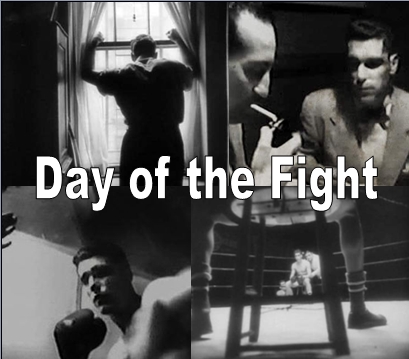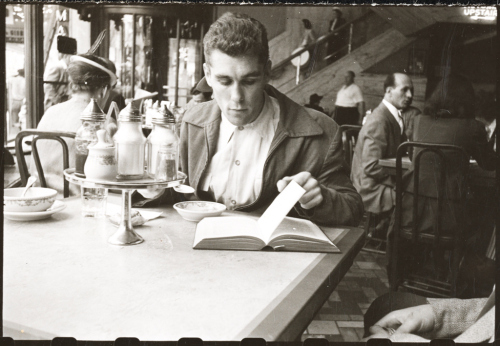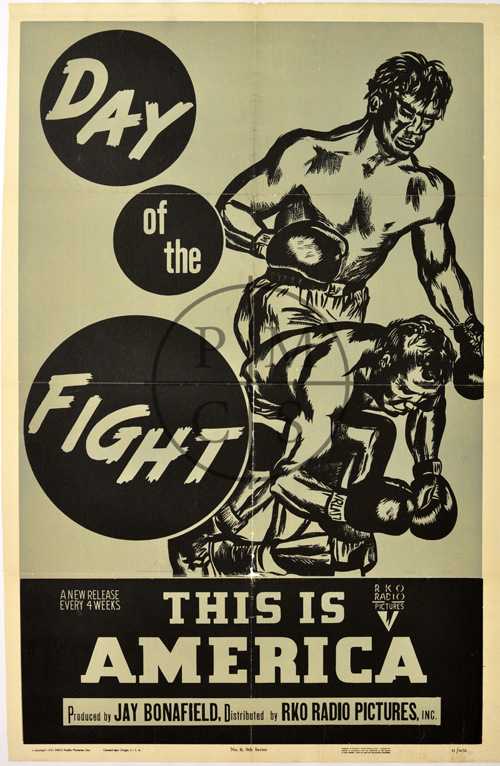 If you go back and look at the very first film that Stanley Kubrick made – a twelve-minute short subject entitled Day of the Fight (1951) – it is obvious that the former photographer for Look magazine already had a striking visual aesthetic and strong sense of narrative technique. Together with his friend and collaborator Alexander Singer, an employee at Time Inc., where The March of Time newsreels were produced, Kubrick decided to create a short film in the style of the popular newsreel based on his photo essay for Look, “Prizefighter,” which profiled middleweight boxer Walter Cartier in the January 18th issue of 1949. Kubrick had learned that a typical eight to nine minute segment for The March of Time cost approximately $40,000 to produce and vowed he could do it more effectively for only $1,500 and make an enormous profit on the film sale.
If you go back and look at the very first film that Stanley Kubrick made – a twelve-minute short subject entitled Day of the Fight (1951) – it is obvious that the former photographer for Look magazine already had a striking visual aesthetic and strong sense of narrative technique. Together with his friend and collaborator Alexander Singer, an employee at Time Inc., where The March of Time newsreels were produced, Kubrick decided to create a short film in the style of the popular newsreel based on his photo essay for Look, “Prizefighter,” which profiled middleweight boxer Walter Cartier in the January 18th issue of 1949. Kubrick had learned that a typical eight to nine minute segment for The March of Time cost approximately $40,000 to produce and vowed he could do it more effectively for only $1,500 and make an enormous profit on the film sale.
Singer, who would serve as the assistant director of Day of the Fight, recalled, “We had a notion that you could get tens of thousands of dollars. We were off by an order of magnitude. The truth was, they gave them away. They were not paid for them at all. The shorts anybody paid for were the comic routines professional vaudeville characters did, not the sort of sports shorts we were contemplating – all of those were throwaways. But what we did know was that what passed for a sports short at the time was pretty low stuff; it was junk. There was no question in our minds that we could vastly exceed the impact and power…Stanley’s concept of using the photojournalist story on Day of the Fight was inspired. Not only were the drama elements of it marvelously compressed, but the subject himself, Walter Cartier, was a textbook hero. Walter Cartier was good-looking and able…and his brother, Vincent, looked good – and the two of them together were really quite marvelous figures.”

Walter Cartier, Prizefighter of Greenwich Village in a restaurant, 1948. (photo by Stanley Kubrick for LOOK Magazine.)
Walter and his brother Vincent had taken a liking to Kubrick when he had previously worked with them on the Look photo essay and agreed to partner with him on his movie with Walter serving as the technical advisor. The story concept was simple but dramatic; it followed a day in the life of boxer Walter Cartier from the moment he woke up in the morning through his breakfast routine and out into the streets of New York City. Using only a narrator (Douglas Edwards from CBS) and a music score by Gerald Fried, Kubrick created an intimate portrait of the boxer, showing him playing with his dog, attending mass at Saint Xavier Church on Sixteenth Street and Sixth Avenue, training with his brother, and eating lunch at his favorite restaurant on Greenwich Avenue, The Steak Joint. It all built to a dramatic finish with Cartier’s bout with middleweight fighter Bobby James at Laurel Gardens in Newark, New Jersey on April 17, 1950.
Even though Day of the Fight offered a time-compressed look at Cartier’s life, it was shot over the course of several weeks and Kubrick’s biggest challenge was capturing the main event with his “Eyemo, a daylight loading camera that takes one-hundred-foot spools of 35mm black-and-white film.” The two filmmakers would only get one opportunity to capture this crucial bout so “Kubrick shot the hand-held material, and Singer operated the second Eyemo positioned on a tripod. They were both shooting hundred-foot loads, which required constant reloading. With two cameras, one could be shooting while the other was reloading.” The final result is a stunningly edited and photographed tour de force with Kubrick often filming the action from the point of view of the canvas floor. An extra bonus was the fact that Cartier won the fight with a knockout punch, captured on film.
Despite Kubrick’s claim that he could make Day of the Fight for a mere $1,500, it actually ended up costing him $3,900 but he was able to sell it to RKO-Pathe for their This Is America series for $4,000 and make a $100 profit. The short subject made its world premiere on April 26, 1951 at New York’s Paramount Theatre where the main feature was My Forbidden Past starring Robert Mitchum and Ava Gardner. Day of the Fight marked Kubrick’s official entry into the film industry and is still regarded by movie critics and boxing fans as the ideal model for a sports film, one that captures the essence of boxing and its drama through sheer artistry.

Prizefighter Walter Cartier gazes out his window in the 1951 short, Day of the Fight (directed by Stanley Kubrick)
Cartier would go on to make boxing history on October 16, 1951, with a knockout punch to Joe Rindone in the first forty-seven seconds of a match. He would also profit from his involvement in Day of the Fight, thanks to his photogenic features and physical grace. Hollywood came calling and Cartier would soon add actor to his resume with appearances in such films as Somebody Up There Likes Me (a 1956 biopic about boxer Rocky Graziano) and Elia Kazan’s A Face in the Crowd (1957) as well as TV shows (You’ll Never Get Rich, Crunch and Dez) and guest appearances on The Ed Sullivan Show.  Unfortunately, Day of the Fight has never been officially released on DVD or Blu-Ray and it may not ever appear in those formats. At the same time, you can easily view the short on a number of internet streaming sites (including YouTube) in varying degrees of quality. In fact, all three of Kubrick’s early shorts including Flying Padre (1951), and The Seafarers (1953), his first color short, can be viewed on the internet. Only The Seafarers is available on DVD and Blu-Ray from Kino Lorber as part of a bonus feature with the main attraction, Fear and Desire (1953), Kubrick’s directorial feature debut.
Unfortunately, Day of the Fight has never been officially released on DVD or Blu-Ray and it may not ever appear in those formats. At the same time, you can easily view the short on a number of internet streaming sites (including YouTube) in varying degrees of quality. In fact, all three of Kubrick’s early shorts including Flying Padre (1951), and The Seafarers (1953), his first color short, can be viewed on the internet. Only The Seafarers is available on DVD and Blu-Ray from Kino Lorber as part of a bonus feature with the main attraction, Fear and Desire (1953), Kubrick’s directorial feature debut.
* This is a revised and extended version of an article that first appeared on the Turner Classic Movies website at tcm.com.  SOURCES:
SOURCES:
Stanley Kubrick: A Biography by Vincent LoBrutto)
Stanley Kubrick: A Biography by John Baxter
Stanley Kubrick: A Biography by Vincent LoBrutto
Other Sites of Interest:
http://www.visual-memory.co.uk/amk/doc/0069.html
http://garywarnett.wordpress.com/page/46/
http://www.brightlightsfilm.com/67/67kubrick.php
http://www.filmthreat.com/features/2365/
http://www.denisbosnic.com/journal/2014/1/29/stanley-kubricks-lost-photography
http://www.filmsnotdead.com/2014/06/20/eyes-wide-open-stanley-kubrick-as-photographer/
http://fan.tcm.com/blogpost/wait-training-day-of-the-fight-1951
https://www.youtube.com/watch?v=519M7nzBRZA



